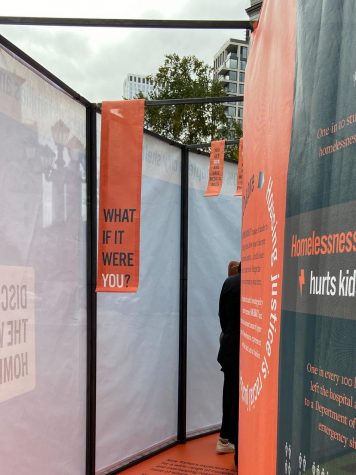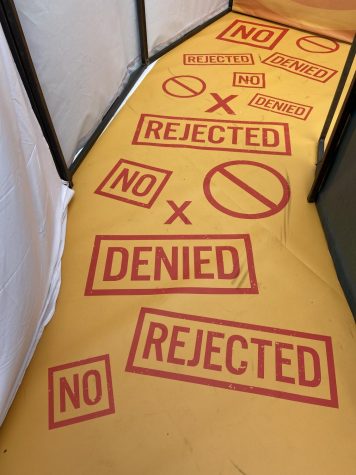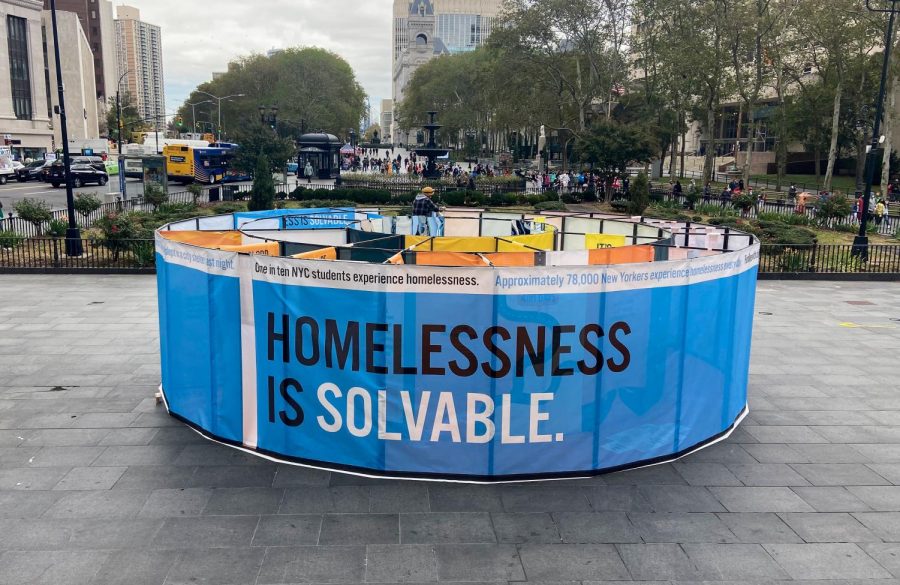Interactive maze exhibit at Astor Place educates on homeless issues
RxHome NYC, an organization dedicated to addressing the struggles that homeless people face in New York City, opened a maze exhibit titled “The Way Home” at Astor Place from Nov. 3-7.
RxHome set up installations in Columbus Park on Oct. 29 and in Astor Place Plaza from Nov. 3 to Nov. 7. RxHome seeks to end homelessness by drawing NYC voters’ attention to the current system that deprives homeless individuals of benefits and rights. (Image courtesy of RxHome)
November 17, 2021
The COVID-19 pandemic has exacerbated New York City’s problems with homelessness. As shelters shut down and income insecurity soared, homeless people became even more vulnerable. Because people living on the street only represent a small percentage of the city’s total homeless population, many broader systemic issues of homelessness remain invisible to the housed public.
RxHome NYC is an organization working to inform New York voters and call on policymakers to improve the city’s broken approach to homelessness. From Nov. 3-7, the advocacy group installed a free interactive exhibit titled “The Way Home” at Astor Place, as well as in Columbus Park outside Brooklyn Borough Hall. The maze-like installation aims to raise public awareness about the daily challenges 78,000 New Yorkers experiencing homelessness face every day.
Caitlin LaCroix, the organization’s co-founder, described the interactive maze experience as one of her team’s strategies to educate the public about the realities of homelessness and the shelter system.
“So many New Yorkers, we know, only understand homelessness as what they see every day,” LaCroix said. “But the data is showing a different picture.”
According to RxHome, almost 80,000 people are in shelters on any given night. One-third of that population are children. However, these numbers do not include those sleeping on the streets or couch surfing with friends and family.
The exhibit guided viewers through the complexity of navigating the homeless system in New York City. Brightly colored banners displayed statistics on the floors and walls of the circular maze, forcing visitors to imagine themselves in the same situations that those in the system are forced to endure.
“What if it were you?” the maze asked visitors as they entered. “Because it’s your first time in a shelter, you must live there for 90 days to qualify for rental assistance. You need rental assistance to pay rent so you can move into an affordable apartment and leave the shelter.”

As visitors move through the labyrinth, the simulated scenarios become increasingly complex. At the maze’s center, visitors are surrounded by small mirrors asking “What does home mean to you?” Visitors were then asked to text their perceptions of home to RxHome. This final exercise aimed to make visitors redefine and reflect on what home meant to them after going through a depiction of the shelter system.
While she was aware of the extent of the homelessness crisis, NYU Global Public Health student Tasfia Bashar particularly appreciated that the installation was placed in an affluent area, presenting an opportunity to educate residents who may not have been aware of the realities of homelessness.
“It’s a nice set-up that really gets people’s attention,” Bashar said. “Just the layout of it — it’s very cool and we follow the actual journey.”

Bashar noted that the installation highlighted common challenges faced by homeless people — for example, the fact that the average homeless person stays in shelters for 495 days.
This installation is just one way RxHome continues to fight for change by educating voters and policymakers to push for legislation that would contribute to ending homelessness.
“We are all really focused on ensuring New York adopts a housing-first approach,” LaCroix said, referring to a policy approach that prioritizes places unhoused people in housing — rather than shelters — without requiring them to first meet preconditions like sobriety.
Through the organization’s public outreach, LaCroix hopes New Yorkers will be encouraged to work to “prevent homelessness from happening in the first place … and solve this crisis in our city.” The exhibit portrayed the problems with the homeless system in an accessible form, and until installations return, RxHome’s website is a great resource for anyone interested to learn more and get involved.
Contact Talia Barrington at [email protected].
























































































































































